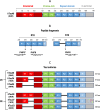Morphological and Molecular Profiling of Amyloid-β Species in Alzheimer's Pathogenesis
- PMID: 39446217
- PMCID: PMC11880078
- DOI: 10.1007/s12035-024-04543-4
Morphological and Molecular Profiling of Amyloid-β Species in Alzheimer's Pathogenesis
Abstract
Alzheimer's disease (AD) is the most common form of dementia around the world (~ 65%). Here, we portray the neuropathology of AD, biomarkers, and classification of amyloid plaques (diffuse, non-cored, dense core, compact). Tau pathology and its involvement with Aβ plaques and cell death are discussed. Amyloid cascade hypotheses, aggregation mechanisms, and molecular species formed in vitro and in vivo (on- and off-pathways) are described. Aβ42/Aβ40 monomers, dimers, trimers, Aβ-derived diffusible ligands, globulomers, dodecamers, amylospheroids, amorphous aggregates, protofibrils, fibrils, and plaques are characterized (structure, size, morphology, solubility, toxicity, mechanistic steps). An update on AD-approved drugs by regulatory agencies, along with new Aβ-based therapies, is presented. Beyond prescribing Aβ plaque disruptors, cholinergic agonists, or NMDA receptor antagonists, other therapeutic strategies (RNAi, glutaminyl cyclase inhibitors, monoclonal antibodies, secretase modulators, Aβ aggregation inhibitors, and anti-amyloid vaccines) are already under clinical trials. New drug discovery approaches based on "designed multiple ligands", "hybrid molecules", or "multitarget-directed ligands" are also being put forward and may contribute to tackling this highly debilitating and fatal form of human dementia.
Keywords: Alzheimer’s disease (AD); Amyloid plaques; Amyloid-beta (Aβ) peptide; Aβ-based therapies; Protein aggregation; Tau protein.
© 2024. The Author(s).
Conflict of interest statement
Declarations. Ethics Approval: Not applicable. Consent to Participate: Not applicable. Consent for Publication: Not applicable. Conflict of Interest: The authors declare no competing interests.
Figures






References
-
- Alberdi A, Aztiria A, Basarab A (2016) On the early diagnosis of Alzheimer’s disease from multimodal signals: a survey. Artif Intell Med 71:1–29. 10.1016/J.ARTMED.2016.06.003 - PubMed
-
- Javaid SF, Giebel C, Khan MA, Hashim MJ (2021) Epidemiology of Alzheimer’s disease and other dementias: rising global burden and forecasted trends. F1000Research 10:425. 10.12688/f1000research.50786.1
-
- (2022) 2022 Alzheimer’s disease facts and figures. Alzheimers Dement 18(4):700–789. 10.1002/ALZ.12638 - PubMed
Publication types
MeSH terms
Substances
Grants and funding
LinkOut - more resources
Full Text Sources
Medical

